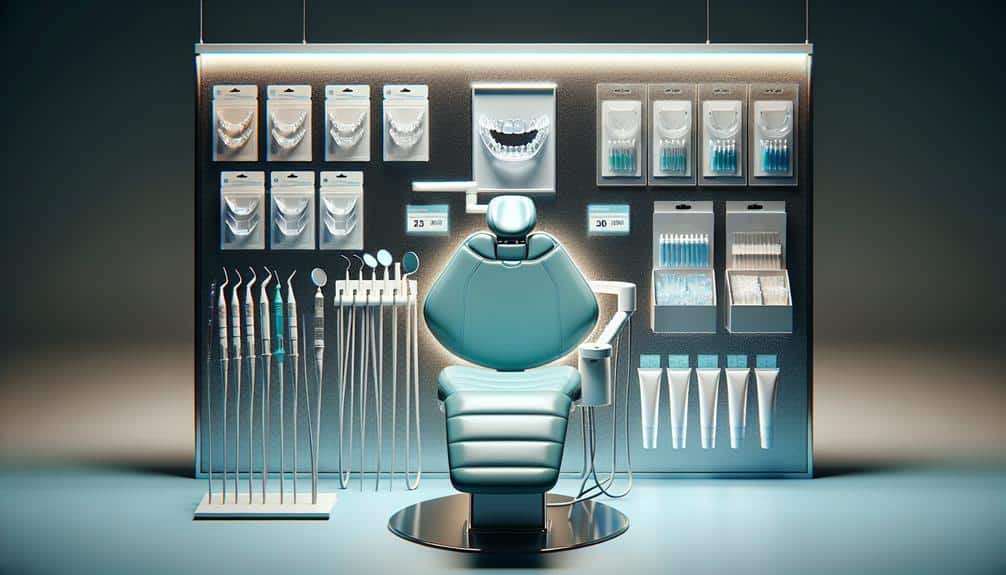When evaluating professional teeth whitening expenses, it's crucial to consider factors like the whitening method chosen, your dentist's expertise, and the location you're in, as these can significantly impact the cost. Comparing prices across different providers and factoring in economic trends can help you make an informed decision.
Calculating the total cost and analyzing the long-term benefits of various procedures will help you determine the most cost-effective option for your teeth whitening investment. Keep in mind that while in-office treatments have a higher upfront cost, they may offer more lasting results compared to at-home kits. Consider these factors to maximize the value of your teeth whitening investment.
Key Points
- Consider long-term benefits and effectiveness.
- Evaluate lasting results for value assessment.
- Compare in-office and at-home costs.
- Opt for budget-friendly options like at-home kits.
- Seek cost-effective solutions for value enhancement.
Factors Influencing Teeth Whitening Costs
When considering professional teeth whitening expenses, various factors like the method chosen, the dentist's proficiency, and the geographical location have a significant impact on determining the overall cost. Pricing strategies in the teeth whitening industry play an important role in setting the cost for various treatments. Dentists may adopt different pricing models, such as charging per session, per tooth, or offering package deals that include multiple sessions at a discounted rate. Market trends also influence pricing, as the demand for certain types of whitening procedures can affect their cost.
Understanding these pricing strategies and market trends can help you make informed decisions when choosing a teeth whitening provider. Additionally, the location of the dental practice can greatly affect the cost, with urban areas generally charging higher fees compared to rural areas due to differences in overhead costs. Dentists with specialized training and advanced equipment may also charge more for their services, reflecting their expertise and the quality of care provided.
Understanding Professional Teeth Whitening Prices
Understanding the intricacies of professional teeth whitening prices requires a thorough analysis of various factors influencing cost. To gain mastery in this area, consider the following:
- Exploration of Pricing: Delve into the components that make up the total cost of professional teeth whitening. This may include the cost of materials, labor, overhead, and any additional services provided during the whitening process.
- Cost Comparison: Conduct a detailed comparison of prices offered by different dental professionals or clinics. Look into the services included in each package, the reputation of the provider, and any additional perks that may justify a higher price.
- Economic Factors: Understand how economic conditions can impact teeth whitening prices. Factors such as location, demand for services, and the level of competition in the market can all influence the cost of professional teeth whitening procedures.
Calculating the Total Cost of Whitening Procedures
To accurately determine the total cost of whitening procedures, assess the individual components that contribute to the overall expense. The cost breakdown typically includes the price of the whitening treatment itself, any additional products or services required, and potential follow-up appointments.
Understanding these elements is important in evaluating the financial investment needed for professional teeth whitening. When calculating the total cost, consider the long-term benefits that professional whitening can offer. While the initial expense may seem higher compared to at-home alternatives, professional treatments often provide more effective and lasting results, which can lead to greater satisfaction and confidence in the long run.
Factoring in these long-term benefits can help justify the upfront cost of professional teeth whitening procedures. By analyzing the cost breakdown and weighing it against the advantages of professional whitening, you can make an informed decision that aligns with your goals for achieving a brighter, more radiant smile.
Comparing In-Office Vs. At-Home Whitening Expenses
Comparing the expenses of in-office and at-home teeth whitening methods provides a clear insight into the cost-effectiveness of each approach. Here's a breakdown to help you make an informed decision:
- Initial Investment: In-office whitening typically incurs a higher upfront cost due to professional services and equipment. At-home kits are generally more affordable, offering flexibility in budget allocation.
- Maintenance Costs: While in-office treatments may provide immediate results, they often require periodic touch-ups to maintain whiteness. DIY options allow for ongoing maintenance at a lower cost, potentially saving you money in the long run.
- Long-Term Effects: Consider the long-term impact on your budget. In-office treatments may seem costlier initially, but their effectiveness and durability could outweigh the expenses of frequent at-home treatments over time.
Evaluating these factors can help you determine which option aligns best with your budget and desired outcomes.
Tips for Maximizing Value in Teeth Whitening Investment
To maximize the value of your teeth whitening investment, strategically assess the longevity and effectiveness of different methods. When considering professional teeth whitening options, it's crucial to weigh the long-term benefits against the initial cost. In-office treatments may yield quicker results, but at-home kits can be more budget-friendly while still providing significant whitening outcomes over time.
To guarantee you're maximizing the value of your investment, look for treatments that offer lasting results. In-office whitening may offer immediate effects, but at-home kits can provide gradual yet sustainable improvements. Consider the duration of the whitening effects when choosing between the two options.
Budget-friendly options like at-home whitening kits can be an excellent choice for maximizing value. These kits are often more cost-effective than in-office treatments and can deliver noticeable results with consistent use over time. By opting for a more affordable solution with long-lasting benefits, you can effectively enhance the value of your teeth whitening investment.
Frequently Asked Questions
Are There Any Potential Risks or Side Effects Associated With Professional Teeth Whitening Procedures That Could Impact the Overall Cost?
Potential risks and side effects from professional teeth whitening may include tooth sensitivity or gum irritation, impacting the overall cost. Understanding effectiveness, longevity, and maintenance costs can help you assess the cost effectiveness compared to at-home options.
Are There Any Additional Maintenance Costs or Products Required to Maintain Whitened Teeth After the Initial Procedure?
When it comes to maintaining your pearly whites post-whitening, there may be some additional costs for whitening aftercare products and touch-up treatments. However, the long-term results are worth it for a dazzling smile.
Is There a Recommended Frequency for Professional Teeth Whitening Treatments to Maintain Optimal Results?
To maintain peak results from professional teeth whitening, it's typically recommended to have treatments every 6-12 months. This frequency helps sustain long-term whitening effects. Incorporating a maintenance routine with whitening products can further enhance and prolong the outcome.
Are There Any Alternative Methods or Treatments for Teeth Whitening That Could Be More Cost-Effective in the Long Run?
When considering cost-effective teeth whitening options long term, explore DIY methods and natural remedies. Home kits and over-the-counter products can also be effective. Researching and comparing the benefits and potential risks associated with these alternatives is crucial.
Do Insurance Plans Typically Cover Any Portion of the Cost for Professional Teeth Whitening Procedures?
Insurance plans typically do not cover professional teeth whitening procedures due to them being considered cosmetic. It's important to compare costs with DIY options and consider limitations on coverage before proceeding with treatment.



